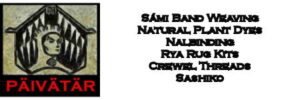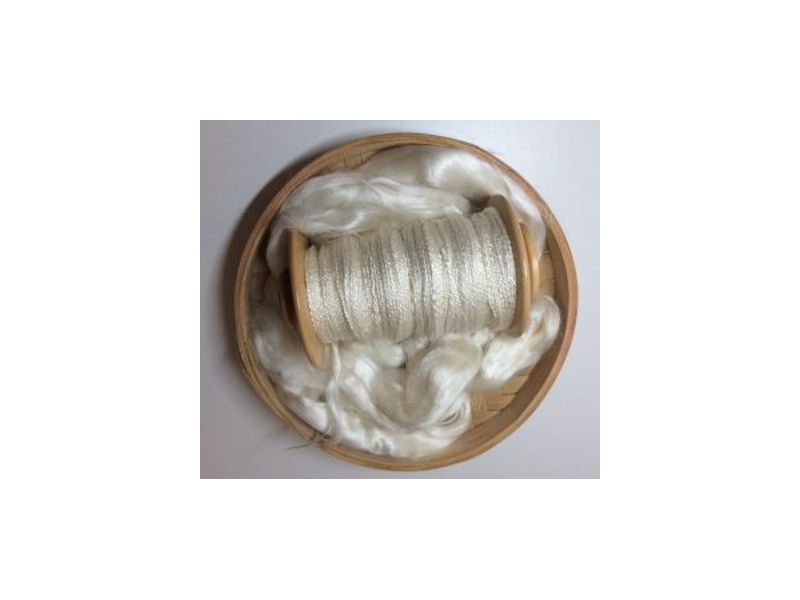For my next Spin Flora not Fauna project, I thought I would spin a bit of rose top. Rose fibre is another one of the ‘new’ vegan handspinning fibres, made from roses. The rose fibre has been extracted from the natural waste of rose bushes and stems. The fibre has been stripped and processed to create a luxurious and soft handspinning spinning fibre, similar to silk.
Rose Top for spinning can now be purchased through my new website: SpinFlora.com
After spinning the Banana fibre, I found the rose to be quite similar, yet the rose top was a bit finer and the staple was shorter in length than the banana fibre. The rose fibres were about 18-20 cm in length, a bit longer than merino top.
How To Spin a Fine Yarn
I wanted to try to spin this fibre a bit finer than I had done with the banana fibre – so I made a few adjustments to my spinning wheel. I replaced the rough brake band that originally came with the wheel, with a smoother and finer hemp yarn. Changing the brake band to a finer yarn, reduces the tension on the brake, as it slips around the bobbin. I removed the metal spring on the brake band with a short elastic band. This allows me to make finer and smoother adjustments to the brake tension.
In order to spin finer yarns, the tension on the brake needs to be reduced, to slow down the speed of the yarn takeup onto the bobbin. This gives your hands more time to draft a smaller amount of fibre during spinning, reducing the thickness of the yarn. There is also less friction placed on the fibres as they are being pulled towards the wheel, so less fibre is picked up by the spinning action of the wheel. By making these small adjustments to your wheel, you can significantly reduce the thickness of your handspun yarn, while keeping the speed of your treadling, and your hand drafting the same. You don’t need to spin faster than your normal spinning rate – let the wheel do the work for you.
Again, I spun the rose fibre using the smallest whorl on my wheel, 14:1. I slowly adjusted the tension on the brake to as slow a speed as I could, making small adjustments at a time, until I was happy with the thickness of the yarn that I was spinning. I wanted the plied yarn to be about a fingering weight.
If you wish to spin an even finer yarn, and you are not achieving it easily with the above adjustments, there are a few more things you can do.
If your bobbin has 2 sizes of whorls on it (such as on a Kromski wheel) turn the bobbin around and use the smaller one – normally I spin using the larger size. A smaller whorl size has less surface area, so the amount of tension that is put onto the bobbin will be less, so the drafting speed will slow down even more, allowing you to spin a finer yarn.
Lacing the yarn around the hooks on the flyer will also slow down the drafting speed of your bobbin. Wrap the yarn around the hooks on the other side of your flyer and back again to the side you normally spin on. Some flyer whorls have the second set of hooks on the same side of the flyer – this makes it easier to do the lacing. On this flyer, the other set of hooks is on the opposite side, so I have wrapped the yarn around the edge of the flyer and back again. I think I will add some additional hooks to the top side.
The photo shows black merino that has been laced around the arms of the flyer.
Rose fibre is very fine and quite slippery so it needs to be spun with a tight twist. The easiest way to tell if your yarn has enough twist, is to pull back about half a meter of the yarn from the bobbin, hold the length between both hands and give it a good tug. If it holds together, then the yarn is strong enough to be used as warp in weaving. If it pulls apart, then more twist is needed.
Using the smallest whorl size of my wheel (14:1) I used a worsted spinning method with a short forward draw, spinning from the top of the fibre bundle in my hand, and carefully drawing out a small amount of fibre at a time and not letting the twist get into the fibre bundle.
These finely spun viscose yarns are also best if you also ply them. Plying takes a bit of extra time, but it helps to create a stable and balanced yarn that will not stretch and pull apart.
Etsy
Look for rose spinning fibre in my SpinFlora Etsy Shop.
2 Ply Rose Fibre Yarn
330 m / 100 grams
14 TPI
Yesterday’s Roses Natural Dye
I had a bit of rose fibre singles left after I had plied my 2 bobbins of singles together. Not being one to waste good handspun, I plied the leftovers with a single ply merino yarn.
I also had some yellow roses that had seen better days. I thought that I would experiment with a rose natural dyebath. Roses dyed with roses seemed like a good idea… I chopped up the roses, leaves and stems into a pot of water and heated the dyebath for a few hours. I then let the rose dyebath cool and sit overnight.

Yesterday’s Roses

Yesterday’s Roses Dyebath
I put the small sample of the Rose/Merino fibre yarn I had spun into an Aluminum Acetate mordant solution overnight.
The next day I reheated the Yesterday’s Rose dyebath and added the pre-mordanted Rose/Merino handspun yarn. I let it simmer for about an hour in the dyebath, turned off the heat, and waited patiently until the next day. Dyeing with plants is not to be rushed.
Madder Root Natural Dye Recipe
Put Madder Root chips (30 grams) into a mesh bag and let them soak overnight in water.
Heat up the dyebath and add pre-mordanted yarn 100 grams.
Simmer for 1 hour and then turn the dyebath off. Let cool and allow the yarn to sit overnight in the madder dyebath.
For this yarn, I used the left over Madder Root dye that I had made a few days ago, as there was still plenty of colour left in the dye bath. I reheated the dyebath and put the rose handspun into the bath. I let it cook for about an hour and then turned off the heat, leaving the yarn to soak in the dyebath overnight.
Aluminum Acetate Mordant
Aluminum Acetate 5% Solution
Dissolve Aluminum Acetate in hot water and add to dyepot. Add 100 gr yarn into the mordant pot and simmer on warm for an hour. Do not bring to a boil. Turn off the heat and allow the yarn to sit in the mordant overnight.
I like to re-use my mordant baths rather than discarding them.
I had some Aluminum Acetate Mordant solution left over from my previous dyebath. I dissolved another 2 grams of Aluminum Acetate in hot water and added this to the mordant bath. I added some more water to the mordant solution and added the rose handspun to soak overnight (no heat).
More Spin Flora not Fauna
Spin Flora – Bamboo Top
Spin Flora – Banana
Buy Spin Flora fibres at SpinFlora.com
AMAZON – Handspinning Books
The Practical Spinner’s Guide – Cotton, Flax, Hemp (Practical Spinner’s Guides)
Spin Flax & Cotton: Traditional Techniques with Norman Kennedy
The Alden Amos Big Book of Handspinning: Being A Compendium of Information, Advice, and Opinions On the Noble Art & Craft
EBAY – Spinning Fibre/Roving
ROVING
 LONGTHREAD MEDIA VIDEO
LONGTHREAD MEDIA VIDEO
 LONGTHREAD MEDIA SUBSCRIPTIONS
HANDWOVEN MAGAZINE
PIECEWORK MAGAZINE
SPINOFF MAGAZINE
LEARN LONGTHREAD MEDIA
PAIVATAR HANDMADE
LONGTHREAD MEDIA SUBSCRIPTIONS
HANDWOVEN MAGAZINE
PIECEWORK MAGAZINE
SPINOFF MAGAZINE
LEARN LONGTHREAD MEDIA
PAIVATAR HANDMADE
 Paivatar on YouTube
Visit my YouTube channel for how-to craft videos.
Paivatar on YouTube
Visit my YouTube channel for how-to craft videos.
Or Please visit my Channel on Rumble for more how-to videos.
https://rumble.com/Paivatar
LIVE STREAMS - Paivatar Studio
KICK
TWITCH MAKERS&CRAFTING
YOUTUBE
Categories: HAND SPINNING, Vegan Fibers











